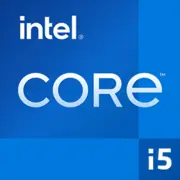Intel Core i5-1038NG7

Intel Core i5-1038NG7: A Moderate Giant for Ultrabooks in 2025
Current Review of the Processor for Thin Laptops
Architecture and Process Technology: 10nm, Ice Lake-U, and Hidden Potential
The Intel Core i5-1038NG7 processor, released in 2020, continues to be in demand in budget ultrabooks even in 2025 due to its balanced specifications.
- Cores and Threads: 4 cores, 8 threads—a classic configuration for medium-complexity tasks.
- Frequencies: Base frequency—2.0 GHz, maximum turbo frequency—3.8 GHz. In Turbo Boost mode, the processor dynamically overclocks, but due to its 15W TDP, it cannot sustain peak values for long periods.
- Ice Lake-U Architecture: The Sunny Cove microarchitecture has brought IPC improvements (up to 18% compared to previous generations), support for AVX-512, and AI acceleration via DL Boost.
- Integrated Graphics Iris Plus G7: 64 execution units (EUs), support for 4K@60 Hz, and decoding of VP9 and H.265. In gaming, it handles CS:GO at medium settings (45–60 FPS) and Dota 2 (720p, 50 FPS).
Practical Tip: For comfortable graphics work, choose laptops with dual-channel RAM (at least 16 GB LPDDR4X). This will increase iGPU performance by 20–30%.
Power Consumption and TDP: A Thin Balance
The 15W TDP makes this processor ideal for ultrabooks, but under load, consumption can reach 25–28W. This requires an efficient cooling system.
- Operating Modes: In office tasks (Chrome, Word), the processor consumes 5–8W; in rendering, it can use up to 25W.
- Thermal Management: In compact chassis (e.g., Dell XPS 13 9300), under load, temperatures can reach 85–90°C, which causes throttling. The solution is to use cooling pads.
Example: The Acer Swift 5 (2025) laptop with the i5-1038NG7 demonstrates stable 3.2 GHz under sustained loads thanks to an improved cooler.
Performance: From Office Tasks to Light Gaming
Office and Multimedia
- Microsoft Office, Browsers: Loading 20 tabs + Zoom—processor performs without lag.
- Photo Editors: Adobe Lightroom—processing RAW files takes 2–3 seconds per image.
- Video Conversion: Rendering a 10-minute 1080p video in HandBrake—about 25 minutes.
Gaming
- Light Projects: Minecraft (60 FPS, 1080p), Overwatch 2 (30 FPS, low settings).
- Turbo Mode: In games, the frequency remains at 3.5–3.6 GHz for the first 10 minutes, then drops to 2.8–3.0 GHz.
Tip: For gaming, use an external graphics card via Thunderbolt 3 (e.g., Razer Core X with GTX 1660). This will expand the laptop's capabilities.
Use Cases: Who is the i5-1038NG7 Suitable For?
- Students: Working with texts, presentations, online courses.
- Office Workers: Multitasking with emails, messaging apps, Excel.
- Travelers: Watching movies, light photo editing.
- Not Suitable For: 4K video editing, 3D modeling, AAA gaming without eGPU.
Example Device: Lenovo Yoga Slim 7 (2025)—weight 1.3 kg, battery life 10 hours, price $799.
Battery Life: How Long Will the Battery Last?
- Web Surfing: 8–10 hours (brightness 150 nits, Wi-Fi).
- Video Playback: Up to 12 hours (local playback of 1080p content).
- Power Saving Technologies:
- Intel Speed Shift: Dynamic switching between P-states.
- Adaptix Dynamic Tuning: Machine learning for load optimization.
Important: In 2025, competitors like Apple M3 or AMD Ryzen 7 7730U offer 30–50% more battery life for similar tasks.
Comparison with Competitors
AMD Ryzen 5 7530U (Zen 3, 6 Cores)
- Pros: Better multi-threaded performance (Cinebench R23: 7500 vs. 4800 for Intel).
- Cons: Weaker single-thread performance (Geekbench 6: 1050 vs. 940).
Apple M3 (8 GPU, 4 Cores)
- Pros: Battery life up to 18 hours, higher IPC.
- Cons: Limited compatibility with Windows software.
Conclusion: The i5-1038NG7 falls short in multi-threading and energy efficiency but wins in price ($600–$900 for laptops vs. $1000–$1300 for Apple).
Pros and Cons
Strengths:
- Good single-thread performance.
- Support for Thunderbolt 4 and Wi-Fi 6.
- Affordable device pricing.
Weaknesses:
- Heating under load.
- Outdated process technology compared to 5nm chips from competitors.
Recommendations for Laptop Choice
- Device Type: Ultrabook or 2-in-1 hybrid.
- Essential Parameters:
- 16 GB RAM.
- 512 GB NVMe SSD.
- IPS display with Full HD resolution.
- Additional: Active cooling, Thunderbolt 4 port for upgrades.
Top Models of 2025:
- HP Envy 13 (price: $849).
- ASUS ZenBook 14 (price: $799).
Final Conclusion
The Intel Core i5-1038NG7 in 2025 is an excellent choice for those seeking an affordable ultrabook for work and leisure. Its key advantages include:
- Sufficient power for everyday tasks.
- Support for modern interfaces (Thunderbolt 4).
- Optimal price-to-performance ratio.
Who it is suitable for: Students, office workers, users who value portability and are not willing to overpay for top-tier models.
Basic
CPU Specifications
Memory Specifications
GPU Specifications
Miscellaneous
Benchmarks
Compared to Other CPU
Share in social media
Or Link To Us
<a href="https://cputronic.com/cpu/intel-core-i5-1038ng7" target="_blank">Intel Core i5-1038NG7</a>